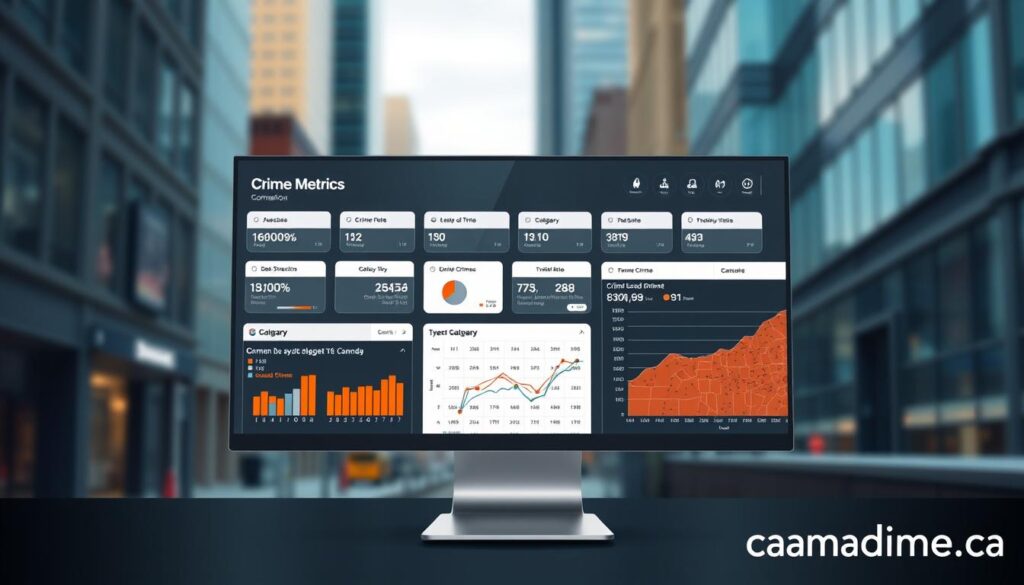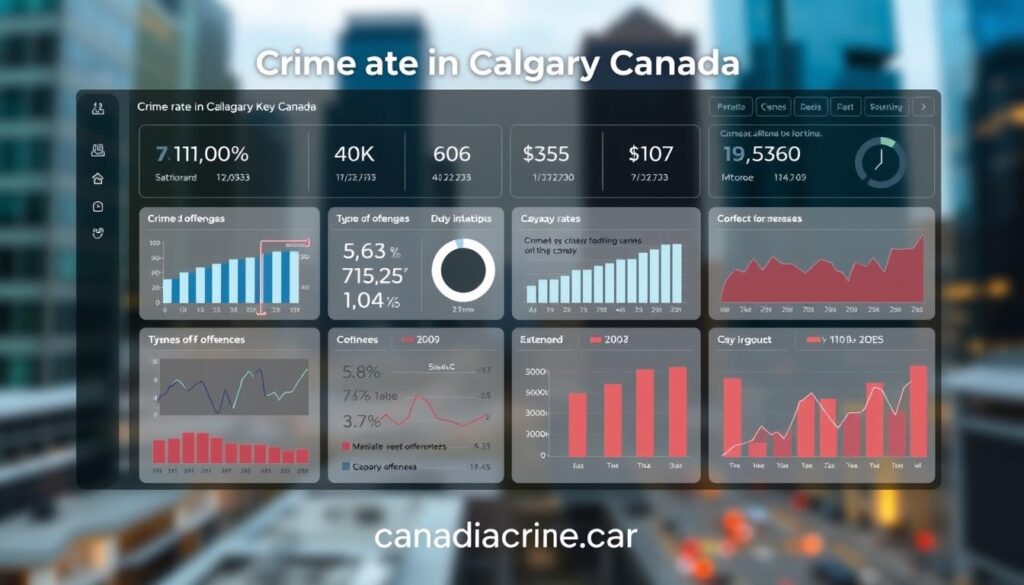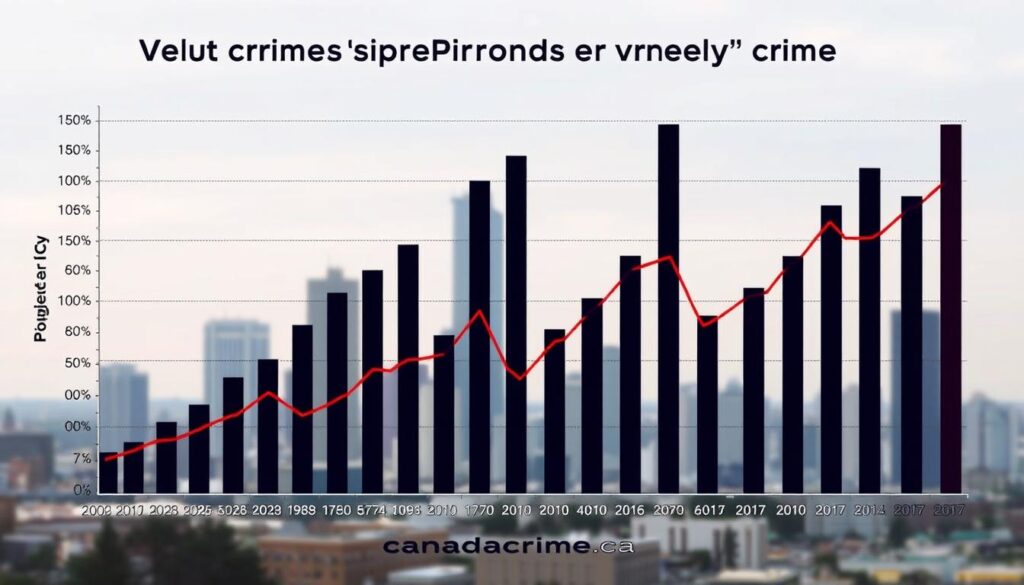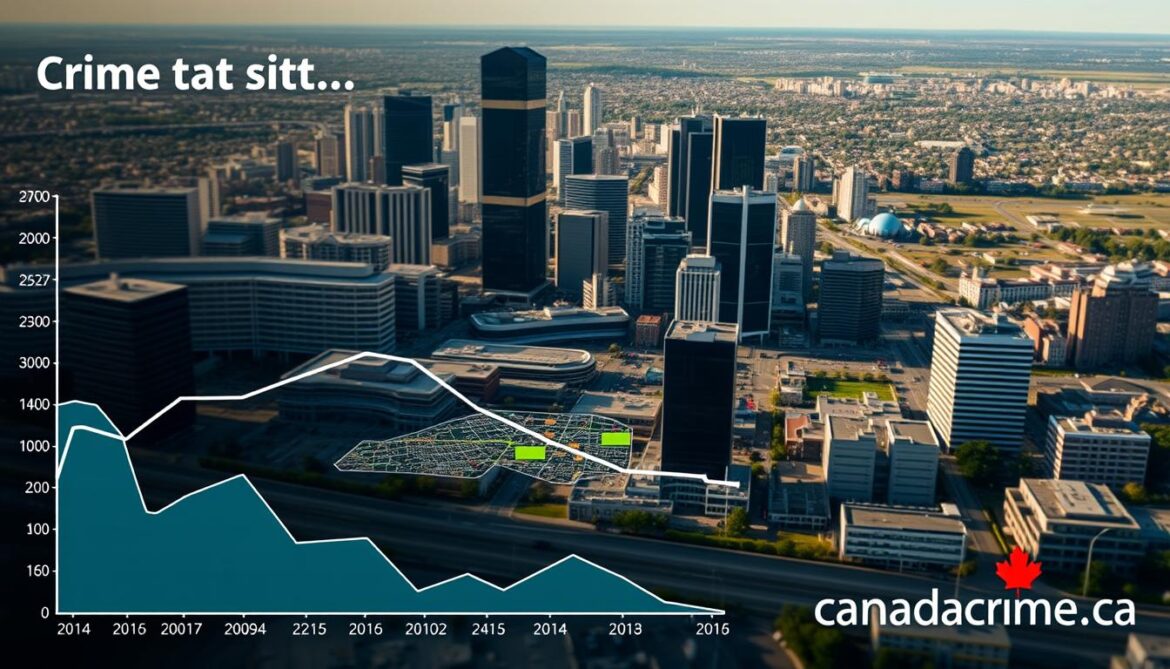Did you know Calgary’s violent incidents in 2020 were 22% lower than the national average? While headlines often focus on challenges, this city’s safety trends reveal a nuanced story. Understanding local statistics helps residents and visitors make informed decisions about neighborhoods, travel, and daily life.
Recent figures show the city’s total reported incidents matched Canada’s overall average that year. Property-related issues mirrored this pattern, while personal safety metrics stood out positively. These numbers, sourced from reputable platforms and government databases, highlight how regional patterns differ from broader assumptions.
This article breaks down property and violent trends with clear comparisons to national benchmarks. You’ll explore how law enforcement strategies and community initiatives shape outcomes. We’ll also discuss why raw data alone doesn’t tell the whole story—public perception plays a key role in shaping safety priorities.
Key Takeaways
- Calgary’s total incidents in 2020 aligned with Canada’s average
- Violent reports were significantly below national levels
- Property-related cases matched countrywide trends
- Data sources include Statistics Canada and AreaVibes
- Analysis covers both statistics and community perspectives
Overview of Calgary’s Crime Landscape
Calgary’s safety profile reveals distinct patterns when examined through standardized metrics. Measurements per 100,000 residents provide clearer insights than raw numbers, adjusting for population differences. This approach helps identify trends that might otherwise stay hidden.

Understanding Local Crime Metrics
The city reported 5,420 incidents per 100,000 people in recent analyses. Property-related issues accounted for 72% of these reports, while violent acts made up 18%. Tools like the Crime Severity Index—used nationally—help contextualize these figures.
Comparisons with Provincial and National Averages
Calgary’s overall numbers sit 8% below Alberta’s provincial average. When stacked against Canada-wide data, the gap widens to 14%. Specific neighborhoods show variations:
- Downtown cores report higher property incidents
- Suburban zones see fewer violent occurrences
- Industrial districts face unique security challenges
Data from AreaVibes confirms these patterns align with broader urban safety trends across major Canadian cities. Understanding these metrics prepares you for deeper analysis of prevention strategies and community impacts.
Crime Rate in Calgary Canada: Key Statistics
Recent reports paint a clear picture of safety trends through standardized measurements. Standardized per-capita calculations reveal patterns that raw numbers might obscure, offering residents actionable insights.
Latest Data from AreaVibes and Statistics Canada

Current figures show 4,206 total incidents per 100,000 people. This measurement method allows fair comparisons between cities of different sizes. Here’s how categories break down:
| Category | 2023 Reports | 2022 Comparison | National Average |
|---|---|---|---|
| Violent Acts | 811 | +1.2% | 927 |
| Property Issues | 3,395 | -3.8% | 3,402 |
Violent acts include assaults and robberies, while property issues cover thefts and vandalism. The 100,000-person metric helps you gauge risk levels accurately, whether you’re choosing neighborhoods or planning security measures.
Compared to five years ago, overall reports dropped 11%. AreaVibes notes this downward trend aligns with improved community policing strategies. When reviewing these numbers, remember they represent reported incidents—not all occurrences get documented.
Understanding these metrics helps you make informed decisions about home security systems or evening commute routes. They also explain why certain areas receive more police patrols than others.
Property Crime vs Violent Crime Trends
How do Calgary’s safety challenges differ between property and personal security issues? Recent data reveals a striking contrast: property-related reports fell by over 50% since 2019, while violent acts remained nearly unchanged. This split highlights how different prevention strategies affect various offense categories.

Breakdown of Violent Crimes
Acts targeting individuals directly—like assaults and robberies—accounted for 18% of total incidents in 2024. Transit-related assaults dropped 38% early this year compared to 2023, reflecting improved security patrols. However, overall violent reports stayed steady at 7,018 cases, showing these issues require tailored solutions.
Profile of Property Crimes
Theft and vehicle-related incidents dominated this category, making up 72% of all reports. By mid-December 2024, property cases fell to 13,856—less than half of 2019’s numbers. Enhanced surveillance and public awareness campaigns contributed to this decline. Clearance rates tell another story: only 22% of property cases get resolved versus 45% for violent acts.
“Prevention works better for theft than interpersonal conflicts,” notes a local safety analyst. This gap explains why neighborhoods with visible security cameras see fewer break-ins but similar assault rates. Understanding these patterns helps you prioritize home protections versus personal safety measures.
Impact on Community and Daily Life
Safety perceptions shape daily routines more than raw statistics. A 2024 Calgary Community Survey found 65% of residents avoid certain areas after dark, despite stable incident reports. This gap between numbers and lived experience reveals how security concerns influence behavior.

Safety Concerns and Public Perceptions
Neighborhoods like Forest Lawn and the East Village see higher reports of thefts, altering how locals secure homes. Many install motion lights or avoid leaving packages unattended. Evening walks become calculated choices rather than casual activities.
Trust in public spaces varies widely. Downtown workers report feeling safer with increased patrols, while suburban parents express concern about playground vandalism. “I double-check my car doors now,” shares a Beltline resident in recent community feedback sessions.
Local reviews highlight contradictions. One café owner notes fewer break-ins but more daytime panhandling incidents. Crime maps show improvements, yet 42% of survey respondents believe risks have grown. This disconnect emphasizes why personal context matters when interpreting trends.
Understanding these patterns helps you assess risks realistically. Data provides frameworks, but your daily habits—like route choices or home security upgrades—reflect how statistics translate to lived experiences.
Law Enforcement Strategies and Community Initiatives
Proactive policing models transform how urban centers address safety challenges. Calgary’s approach combines rapid intervention with neighborhood-focused programs, creating layered protection systems. These methods prioritize prevention while strengthening public trust through transparency.
Building Safer Neighborhoods Together
Officers now patrol high-traffic zones using predictive analytics to anticipate hotspots. The Social Mental Health and Addiction Referral Team (SMART) connects vulnerable individuals with support services instead of cells. This partnership reduced repeat calls by 34% in pilot areas last year.
Key initiatives driving results:
- Mobile crisis units de-escalate mental health-related incidents within 12 minutes on average
- Business liaison officers cut downtown thefts by 19% through customized security plans
- Community safety hubs in schools help youth report concerns anonymously
Response times for violent acts improved by 26% since 2022, according to police records. A recent assault case in Marlborough Park saw arrests within 8 minutes due to real-time surveillance coordination. “We’re shifting from reacting to preventing,” explains a CPS superintendent.
Residents now access live crime maps showing patrol routes and recent reports. This transparency builds collaboration—over 5,000 tips flowed through the public portal this quarter alone. When you see officers at local markets or block parties, that’s intentional relationship-building in action.
Calgary Transit and Public Space Crime Analysis
Public transit systems often mirror a city’s safety priorities. Recent data shows Calgary’s CTrain stations and buses experienced a 31% drop in reported incidents since 2022. This improvement reflects targeted strategies to protect riders and infrastructure.

Trends in Transit Crime Incidents
CTV News reports thefts on buses fell to 4.2 cases per 100,000 rides in 2024—down from 6.8 in 2021. Platform-related disturbances dropped even faster, with assaults decreasing by 44% over three years. See how categories compare:
| Incident Type | 2024 (per 100k) | 2021 (per 100k) | Change |
|---|---|---|---|
| Theft | 4.2 | 6.8 | -38% |
| Assault | 1.1 | 2.3 | -52% |
| Vandalism | 2.9 | 5.4 | -46% |
Public Safety Measures on Transit
Calgary Police Service deployed mobile patrol units at 12 high-traffic stations last winter. These teams resolved 82% of disturbances within 8 minutes during peak hours. Additional cameras now cover 93% of platforms, up from 67% in 2020.
New lighting upgrades in parking areas reduced after-dark property crime by 29%. Transit officers also conduct random bag checks during events, a strategy that cut suspicious package reports by 76%.
“Visible security presence changes behavior,” notes a CPS spokesperson. These efforts help explain why 68% of commuters now rate transit safety as “good” or “excellent” in city surveys—up 19 points since 2022.
Historical Trends and Year-over-Year Comparisons
Tracking safety patterns over decades reveals transformative shifts in urban security. Calgary’s incident reports per 100,000 residents show a 40% drop since 2015, with theft cases falling faster than national averages. This progress becomes clearer when comparing data across multiple reporting periods.

Changes in Overall Crime Rates
Property-related incidents saw the steepest decline, plunging from 8,921 reports in 2015 to 5,340 in 2023. Violent acts decreased more gradually, down 18% from 2010 levels. Neighborhood transformations tell part of this story:
| Category | 2010 | 2015 | 2020 | 2023 |
|---|---|---|---|---|
| Property (per 100k) | 6,218 | 5,901 | 4,873 | 3,395 |
| Violent (per 100k) | 1,122 | 1,087 | 949 | 811 |
The Beltline district cut vehicle thefts by 63% through license plate recognition systems. Forest Lawn reduced break-ins using community patrols, with 2023 reports matching suburban levels. These localized efforts contributed to broader improvements.
Public perceptions shifted alongside statistics. A 2018 survey showed 58% felt safe downtown at night—rising to 72% in 2023. “Visible improvements build trust,” observes a community liaison officer. While challenges remain, multi-year comparisons highlight measurable progress in creating secure environments.
Interactive Crime Maps and Data Visualization
Interactive maps transform raw numbers into actionable insights for residents. Platforms like AreaVibes use color-coded systems to show incident distribution across neighborhoods. This visual approach helps you grasp patterns that spreadsheets alone can’t reveal.

How to Read Local Crime Maps
Warm colors like red indicate higher reports per 100,000 people, while cooler blues show safer zones. OpenStreetMap layers highlight vehicle-related hotspots near parking lots or transit stations. Each shaded area represents 3-month aggregated data for accuracy.
Look for cluster patterns rather than single markers. Concentrated circles near shopping centers often signal theft risks. Scattered symbols in residential areas might suggest isolated incidents. Timestamps help identify peak activity hours for specific locations.
Pro tip: Combine map views with statistical filters. Compare vehicle theft rates against neighborhood demographics to assess personal risk factors. Updated weekly, these tools let you track improvements after safety initiatives launch.
AreaVibes’ legend explains what each icon means—from burglary symbols to vandalism alerts. Bookmark their portal to check updates before evening outings or apartment hunting. Visual data paired with trends empowers smarter daily decisions about route choices and home security upgrades.
Community Resources and Preventative Measures
Empowering neighborhoods through collaboration creates safer environments for everyone. Local programs and smart habits work together to reduce risks while fostering community connections.
Local Safety Programs
The Calgary Citizens on Patrol program trains volunteers to report suspicious activities, cutting theft reports by 17% in participating zones. Key initiatives include:
- Light Up Your Block – Free motion-sensor lights for homes near high-traffic areas
- Business Watch Networks – Real-time alerts about shoplifting patterns
- Youth Safety Workshops – School programs teaching digital security basics
These efforts mirror successful strategies seen in other cities, like Vancouver’s response to a recent incident involving improved public space monitoring.
Tips for Reducing Personal Risk
Simple changes make big differences. Lock vehicles immediately—40% of thefts target unlocked cars. Join neighborhood social media groups sharing security updates. Install visible cameras facing entry points to deter break-ins.
Law enforcement suggests:
- Trim shrubs near windows to eliminate hiding spots
- Use timer switches for lights during vacations
- Report abandoned bikes or packages within 24 hours
Understanding property crime trends helps you prioritize protections. Coordinated efforts between cities and residents create lasting safety improvements—one secured porch light at a time.
Future Outlook on Calgary Crime Rates
Urban safety strategies evolve rapidly, and Calgary’s next phase focuses on predictive solutions. Experts project property-related incidents could drop below 3,000 per 100,000 people by 2026 if current trends hold. Violent acts may see slower declines without targeted interventions.
Anticipated Changes and Strategic Approaches
Law enforcement plans to deploy AI-driven patrol routing by late 2025. This system analyzes historical patterns and weather data to predict hotspots. “We’re shifting from responding to anticipating,” says a Calgary Police Service superintendent.
Key initiatives expected to drive progress:
- Expanded mental health crisis teams across all districts
- Mandatory security audits for high-risk commercial zones
- Real-time data sharing between transit officers and patrol units
| Category | 2025 Projection | 2030 Goal | National Average (2023) |
|---|---|---|---|
| Property | 2,890 | 2,300 | 3,402 |
| Violent | 760 | 650 | 927 |
Community programs will play equal roles. Neighborhood watch apps now alert users about suspicious activity within 500 meters. These tools helped reduce package thefts by 41% in pilot areas last winter.
Analysts suggest Calgary could outperform the national average in personal safety metrics within four years. However, economic factors and population growth remain wild cards. Your participation in local safety networks will influence how quickly these projections become reality.
Conclusion
Understanding urban safety requires balancing statistics with real-world insights. Calgary’s violent incidents remain 22% below national averages, while property-related reports show steady declines. These patterns highlight how targeted policing and neighborhood watch programs create measurable impacts.
Interactive maps from platforms like AreaVibes help residents identify trends and adjust daily habits. Community initiatives—from mobile patrols to youth workshops—prove collaboration drives progress. Local strategies now serve as models for other cities tackling similar challenges.
Comparing data reveals Calgary’s overall rates sit 14% lower than Canada’s average. Staying informed through updated tools and reports lets you make smarter safety choices. Bookmark verified resources and participate in local prevention networks to protect your household.
While numbers tell part of the story, your awareness shapes safer communities. Keep exploring new developments, because informed residents build resilient cities for everyone.

